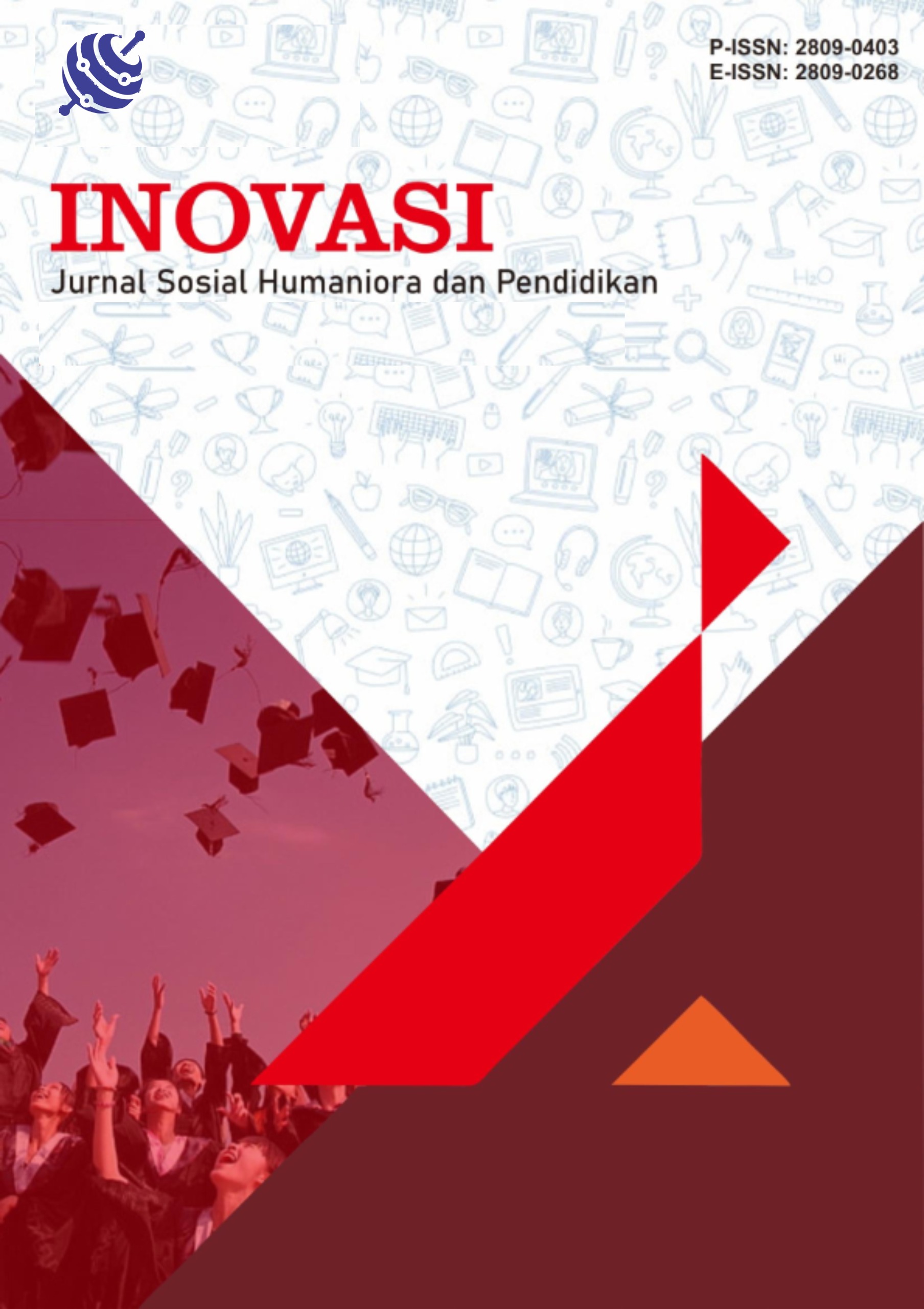Analisis Bentuk Campur Kode Content Creator Pada Akun @furkysyahroni di Aplikasi TikTok
DOI:
https://doi.org/10.55606/inovasi.v4i1.4360Kata Kunci:
Code Mixing, Language, TikTokAbstrak
This study discusses the form of code mixing content creators on the TikTok application. Data in the form of words, phrases, and clauses, the data source of this study is code mixing content creators in the video account @furkysyahroni found in the TikTok application. The data collection method uses the reading method. Basic tapping techniques and advanced reading techniques free from conversational involvement . The results of the study found code mixing forms in the form of words, phrases, and clauses. The conclusion of the author's research found 21 data from the video of 1 content creator uploaded by @furkysyahroni on the TikTok application . Of these, 13 data are included in the category of code mixing forms of word insertion, 7 data are code mixing forms of phrase insertion, and 1 data is code mixing forms of clause insertion.
Referensi
1) A. Hidayah, Code mixing in the language of the E-KTP mega-corruption trial and its implications for learning Indonesian language and literature, Thesis, UIN Syarif Hidayatullah Jakarta, 2019.
2) A. Puteri, J. T. Sijabat, V. Pinem, E. Sitohang, and V. O. Putri, “Syntax in forming sentences, phrases and clauses orally and in writing,” Syntax: Publication of English Language and Literature Experts, vol. 2, no. 6, pp. 138–150, 2024.
3) C. S. Ayu and M. Hadiwijaya, “The influence of language use on social structure and individual identity,” Scientific Journal of Language and Literature, vol. 1, no. 4, Yogyakarta: Pustaka Ilmu Sosial, 2023.
4) E. Edi, L. S. Usop, I. Perdana, E. Elnawati, and S. Oktaviani, “Code mixing in the novel Resign! (2018) by Almira Bastari,” in Proc. Nat. Sem. Educ., Lang., Lit., Arts, Cult., vol. 1, no. 1, pp. 75–89, May 2022.
5) E. Siagian, N. W. Meidariani, and N. L. G. Meilantari, “Code mixing in JKT48 song lyrics by Yasushi Akimoto,” Daruma Journal: Japanese Linguistics, Literature and Culture, vol. 2, no. 3, pp. 73–79, 2022.
6) E. Susylowati et al., Sociolinguistics: Theory and Application, Tulung, Klaten, Central Java: IKAPI No. 267/JTE/2023, 2024.
7) F. P. Hikmarezki, W. Widayati, and N. Mardiana, “Code mixing on Instagram social media ‘Overheardbeauty’,” Jurnal Syntax Imperatif: Jurnal Ilmu Sosial dan Pendidikan, vol. 5, no. 2, pp. 219–224, 2024.
8) H. Hidayah, N. A. Ritonga, and A. Yani, “Successful content creator training for PSB (New Student Admissions) using Adobe Photoshop at the Hidayatullah Foundation, Batam,” Al Muharrik Karimun Journal, vol. 2, no. 1, pp. 13–17, 2022.
9) M. Fredy, Y. Andraini, I. F. A. Putri, W. Wardinda, and L. U. Hasanah, “Code switching and code mixing in the lyrics of the song Dreamers by ATEEZ on the ending soundtrack of the anime Digimon Adventure,” Mezurashii: Journal of Japanese Studies, vol. 5, no. 1, pp. 77–90, 2023.
10) M. Hilmi, Code switching and code mixing in the teaching and learning process in ballet class, Thesis, UIN Syarif Hidayatullah Jakarta, 2020.
11) M. Suratiningsih and P. Y. Cania, “Sociolinguistic study: Code switching and code mixing in the video podcasts of Deddy Corbuzier and Cinta Laura,” Bahtera Indonesia: Journal of Indonesian Language and Literature Research, vol. 7, no. 1, pp. 244–251, 2022.
12) N. Amriyah and H. Isnaini, “Sudjiwo Tedjo's code mixing in the interactive dialogue of Indonesia Lawyers Club TvOne episode One Year of Jokowi-Ma'ruf: From pandemic to democracy,” Disastra: Journal of Indonesian Language and Literature Education, vol. 3, no. 1, pp. 93–103, 2024.
13) N. Budiman, D. S. Ningsih, and M. K. Harahap, “Basics of dialectology: Understanding language variation in a social society,” Tambusai Education Journal, vol. 8, no. 1, pp. 1353–1359, 2024.
14) N. P. C. P. Utami, “Analysis of the variety of language terms in tourism advertisements on digital media during the COVID-19 pandemic,” Journey: Journal of Tourismpreneurship, Culinary, Hospitality, Convention and Event Management, vol. 4, no. 1, pp. 19–42, Jun. 2021.
15) P. N. Rahmana and R. Damariswara, “Utilization of the TikTok application as an educational medium in the Generation Z era,” Akademika, vol. 11, no. 2, pp. 401–410, 2022.
16) P. W. Savitri, “Language variations of content creators on YouTube: A sociolinguistic study,” in Proc. Nat. Sem. Linguist. Lit., 2021.
17) R. Prasetyaningrum, “The influence of social media on language style in writing Indonesian in adolescents,” Journal of Social Humanities and Education, vol. 3, no. 1, pp. 127–134, 2024.
18) R. Rulyandi, M. Rohmadi, and E. T. Sulistyo, “Code switching and code mixing in Indonesian language learning in high school,” Pedagogia, vol. 17, no. 1, pp. 27–39, 2014.
19) Sumarsono and L. Pratama, “Sociolinguistics: Theory and application in society,” Journal of Linguistics and Education, vol. 12, no. 1, pp. 45–60, Jakarta: Language and Literature Publisher, 2023.
20) T. N. Chinita, Language variations in the use of Instagram social media by high school students and their implications in learning Indonesian language and literature, Thesis, Jakarta State University, 2020. [Online]. Available: http://repository.unj.ac.id/id/eprint/12345
21) U. Mansyur, “Indonesian in the entanglement of social media: From cabe-cabean to the interpretation of Al-Maidah 51,” in Proc. Nat. Sem. Fac. Cult. Sci., pp. 145–155, 2016.
22) U. N. Sa’idah, I. R. Tantyas, and D. Murtisari, “The influence of slang on affective development in adolescents in Pekalongan Regency,” in Scientific Meeting of Indonesian Language and Literature, 2018.
23) V. O. Kudairi, T. I. Kusumawati, and B. Budiman, “Analysis of Batak language code mixing during learning in class X of SMA YAPIM Merek in the 2023/2024 academic year,” Syntax: Publication of English Language and Literature Experts, vol. 2, no. 5, pp. 13–29, 2024.
Unduhan
Diterbitkan
Cara Mengutip
Terbitan
Bagian
Lisensi
Hak Cipta (c) 2025 Jurnal Sosial Humaniora dan Pendidikan

Artikel ini berlisensiCreative Commons Attribution-ShareAlike 4.0 International License.







